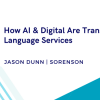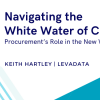Robotic process automation is based on a new type of software. But will it result in a new type of outsourcer? James Hall, Founder and CEO of Genfour, thinks so. Welcome to the world of the virtual outsourcer.
With a career that includes spells with a number of the giants of the outsourcing industry – Accenture, IBM, Capita – James is well placed to speculate on the future of the outsourcing industry that has grown and flourished for the past twenty years. But his view is that the old model – large outsourcers, running enormous workforces, often in globally competitive locations such as India, Poland or the Philippines – has run its course. “Labour arbitrage is on the way out.’”
In its place he sees the growth of the ‘virtual workforce.’
“The future is less about armies of people, it will be technology enabled.” And this applies to outsourcing services as much as inhouse operations. So instead of serving up outsourcing services to the massed ranks of the FTSE 500 through the blood, sweat and tears of thousands of staff, the outsourcer of the future will have a few people and a lot of technology.
Rebuilding the giants of outsourcing as robot-driven enterprises could be the work of a lifetime (even if IBM’s Lou Gerstner once claimed that elephants can dance). Instead James and Genfour took the view that it is quicker and better to start from scratch. “At Genfour we are building a BPO company without any people in it.” A mild exaggeration for poetic effect perhaps – Genfour has a team of some 40+ developers and technicians focused in its Cwmbran service centre in Wales. But the point is still valid: Genfour offers services to a wide clientele, with a small core team and a lot of software robots.
Genfour is still a very young company, but it is gaining momentum. It has been in business since 2012 and its client roster includes names such as the RAC, eSure, NHS, Cooperative Bank. James notes continuing high levels of interest in the insurance sector, banking and utilities, and growing traction amongst others such as various European governments, and in Finance and Accounting (in particular Order to Cash and Record to Report).
So what do clients get from a virtual outsourcer? If the benefits of RPA are clear (think slashing the cost of transactional work, releasing talent to focus on more important work, improving quality, speed and compliance), the question moves to one of delivery – how best to get these benefits. Doing it yourself is a key option, but for many the logic of outsourcing remains – getting a specialist to deliver a service in which you have limited expertise or limited interest. The question is then who is best placed to deliver automated services, a ‘traditional’ outsourcer, or one specialised in the next generation of automation.
A frequent complaint of outsourcing customers today is that their suppliers are not incentivised to deploy RPA, as this would cannibalise the high revenues of their people-based contracts. James sees this as a big driver of his business: “We are being asked to disintermediate the established outsourcers; their clients don’t necessarily trust them and want to get more control back.” There is also an implicit push towards bringing any remaining work back onshore: ‘It can be hard to make RPA work through a connection to India.”
What then does Genfour or a virtual BPO provider do for a client? Firstly it includes implementation – configuring the RPA software for the client’s processes. Genfour is not a software development company and does not sell its own RPA product, instead it has allied with many of the key new names in automation such as UIPath, Celaton or Blue Prism, giving access to the right technologies for the client’s situation. “We are technology agnostic, it is all about offering the best tools to do the best job.” It is also not just about RPA, and James sees Genfour mixing many complementary automation technologies together, such as Optical Character Recognition and cognitive computing.
Even more than implementing RPA, Genfour is focused on the long-term, annuity picture – hosting, maintaining and managing the robot software for the years ahead. In old outsourcing terms, the transition is over in months, but the outsourcing run can last five years, 10 years, or longer. (No doubt someone will coin the phrase Robots-as-a-Service, I want no part in it). The thinking is that companies do not have the skills or inclinations to run and improve large robot workforces, and it makes sense to leave this to a specialist outsourcer.
Finally virtual outsourcers could play a role in the much discussed ‘value add’ of robotics – generating insight from the new flows of digital data that RPA will help to create. This means that Genfour and other outsourcers could be scaling up their analytics teams, or perhaps automating this through Artificial Intelligence. This could ultimately the biggest impact of RPA – changing what businesses know and do. But for the moment this opportunity is still in the future tense, and the practicalities of making RPA work are the first order priority.
Like Blue Prism, James notes that getting robotics up and running with a virtual outsourcer isn’t all plain sailing. In particular building the momentum needed to change is important – and a recurring issue is that buyers of robotics sometimes start too small. Whilst working at a departmental level is pragmatic, this can result in a lack of senior sponsorship, and James cites cases of “unemployed robots” for which licenses have been bought, but have not yet been set to work. “Why start small and timid? Start with ambition.”
James also notes that we are still in the foothills of the RPA journey. One day reality will overtake the hype, but we are not there yet. He notes that few RPA implementations are large scale, with most projects having tens of robots, rather than hundreds (albeit each robot works 24/7 and is three times more productive than a human). Yet momentum is building – James believes we are through the first trailblazing days of RPA innovation, and into a phase of early adoption. Next stop – the mainstream.
So as RPA accelerates, there are two groups of buyers who will shape the destiny of firms like Genfour. Firstly the buyers of traditional outsourcing: will they migrate in numbers to a virtual service provider, or will they stay with the familiar faces? Secondly those companies that currently don’t outsource: will they be attracted or compelled to working with a virtual robotics outsourcer? Most companies haven’t got beyond the first tentative steps into RPA, but in the coming years all are going to need a proper RPA strategy, and answer the question of where the robots should live.
Paul Morrison is a Partner at Aecus, the specialist outsourcing, shared service and automation consultancy. Follow him on Twitter at @MorrisonPaul1 and at aecus.com.





